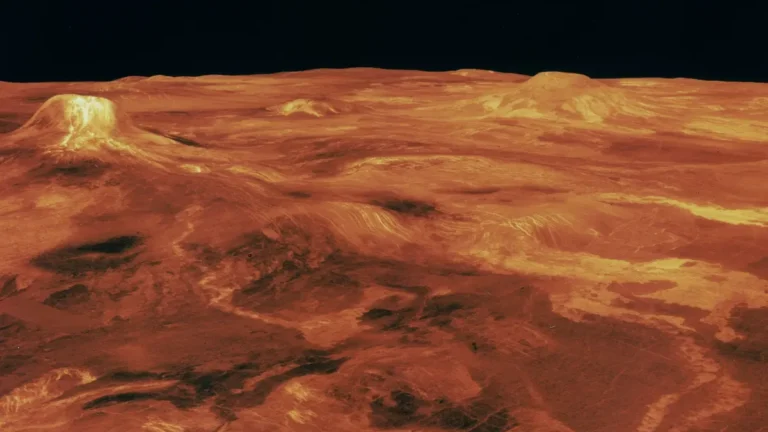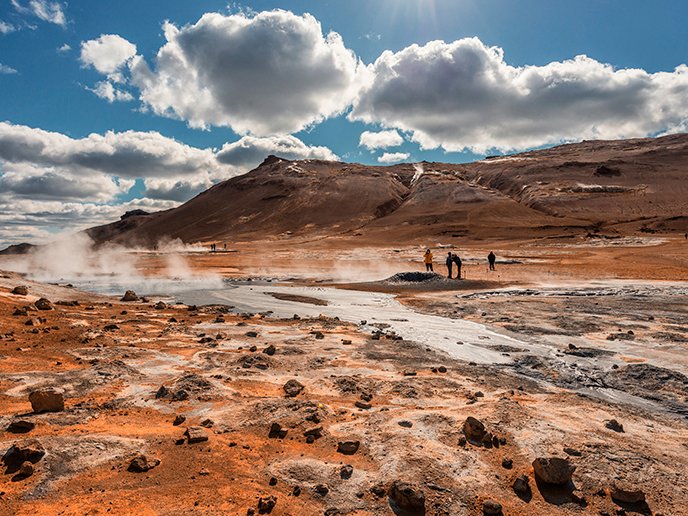Is It Possible To Land On Venus?

Is landing on Venus feasible? In the pursuit of exploring the most extreme environments in our solar system, Venus emerges as a formidable challenge. Often dubbed Earth’s “sister planet” because of its similar size and composition, Venus presents an environment that is far from hospitable.
This article explores the complexities of attempting a landing on Venus, a planet notorious for its intense heat, crushing atmospheric pressure, and corrosive cloud cover

The Harsh Reality of Venus
Venus’s environment is nothing short of apocalyptic. Surface temperatures average around 900 degrees Fahrenheit (475 degrees Celsius), a heat level that would melt lead and render most materials useless. This extreme warmth results from a runaway greenhouse effect, where thick clouds of carbon dioxide trap heat in the planet’s atmosphere.
The atmospheric pressure on Venus is approximately 92 times that of Earth, equivalent to the pressure found 3,000 feet underwater in Earth’s oceans. This immense pressure would crush any spacecraft or lander that attempted to descend to the surface.
Moreover, the Venusian atmosphere is filled with dense clouds of sulfuric acid, making it not only corrosive but also hazardous for electronic equipment and instruments. The winds in the upper atmosphere can reach speeds of up to 200 miles per hour (320 kilometers per hour), while the lower atmosphere is relatively calm but still poses severe challenges.

So Is it possible to land on Venus? Attempting a Landing
The pursuit of interplanetary exploration has always driven the boundaries of engineering and technology. Among the many celestial bodies that pique our curiosity, Venus stands out as one of the most challenging targets due to its extreme environmental conditions.
Designing a spacecraft capable of landing on Venus involves overcoming numerous engineering hurdles that test the limits of current technology. This article delves into the specific design and engineering challenges faced when developing spacecraft for Venus missions.
1. Extreme Temperature Management
Venus’s surface is characterized by temperatures averaging around 900 degrees Fahrenheit (475 degrees Celsius), hotter than any other planet in our solar system. This intense heat poses a significant challenge for spacecraft design:
Thermal Protection Systems: Traditional heat shields and thermal protection systems are insufficient for Venusian conditions. Engineers must develop advanced thermal insulation materials capable of withstanding such extreme temperatures. For instance, multilayer insulation (MLI) used in space missions would need enhancements to handle the continuous heat of Venus’s surface.
Active Cooling Mechanisms: To prevent overheating, spacecraft may require active cooling systems. These systems must efficiently dissipate heat away from sensitive components and maintain operational temperatures within the spacecraft. Techniques such as radiative cooling, where heat is radiated away into space, could be integral to this solution.
Heat-Resistant Materials: The spacecraft’s exterior and internal components must be made from materials that resist high temperatures without degrading. Research into advanced ceramics, refractory metals, and heat-resistant polymers is crucial for developing materials that can endure Venus’s harsh environment.
2. High Atmospheric Pressure
Venus’s surface pressure is about 92 times that of Earth’s, equivalent to the pressure found 3,000 feet underwater on Earth. This extreme pressure creates several engineering challenges:
Structural Integrity: Spacecraft designed to land on Venus must be built to withstand immense pressure. This requires reinforcing the structural components to ensure they do not collapse under the weight of the Venusian atmosphere. Advanced composite materials and innovative structural designs are essential to achieving this goal.
Pressure Vessels: The spacecraft’s pressure vessels, which house scientific instruments and electronics, must be exceptionally robust. Designing these pressure vessels involves extensive testing and the use of high-strength alloys or composite materials to ensure they can endure the atmospheric pressure without failing.
3. Corrosive Atmospheric Conditions
The Venusian atmosphere contains dense clouds of sulfuric acid, making it highly corrosive:
Protective Coatings: To prevent rapid degradation of spacecraft surfaces, engineers must apply specialized coatings that can withstand acid corrosion. These coatings must be resilient enough to protect the spacecraft from the corrosive effects of sulfuric acid rain and atmospheric particles.
Material Selection: The selection of materials for the spacecraft must consider their resistance to chemical corrosion. Advanced materials such as certain metals, ceramics, and composites are being researched and tested for their durability in corrosive environments.
4. Advanced Communication Systems
Venus’s thick cloud cover and dense atmosphere present challenges for communication:
Signal Penetration: Radio signals have difficulty penetrating Venus’s atmosphere, which impacts data transmission. Engineers need to develop communication systems that can function effectively under these conditions. This may involve the use of low-frequency radio waves or innovative communication techniques.
Data Storage and Transmission: Given the challenges of real-time communication, spacecraft may need robust onboard data storage systems to collect and store data for later transmission. High-capacity storage and efficient data compression techniques will be crucial for maximizing the amount of information sent back to Earth.
5. Power Generation and Storage
Providing power to a Venusian lander presents unique challenges due to the planet’s extreme environment:
Power Sources: Solar panels, which are commonly used in space missions, would be ineffective on Venus’s surface due to the thick cloud cover. Alternative power sources, such as radioisotope thermoelectric generators (RTGs), might be necessary. RTGs generate electricity through radioactive decay and are well-suited for long-duration missions in harsh environments.
Energy Storage: Efficient energy storage systems are required to ensure that the spacecraft can operate continuously. Advanced batteries or other energy storage technologies must be capable of functioning reliably under high temperatures and providing sufficient power for all mission operations.
Designing a spacecraft to land on Venus presents numerous engineering challenges, including managing extreme temperatures, immense pressure, and corrosive conditions, while maintaining reliable communication.
Advances in materials science, structural engineering, and thermal management are essential for creating spacecraft capable of withstanding Venus’s harsh environment. As technology progresses, these challenges provide opportunities for breakthroughs that could pave the way for future missions to explore this enigmatic and extreme planet.

Is it possible to land on Venus? Venus, often dubbed Earth’s “sister planet” due to its similar size and proximity, presents a profoundly inhospitable environment. The extreme temperatures on Venus make it one of the most challenging destinations for space exploration. With surface temperatures soaring to nearly 900 degrees Fahrenheit (475 degrees Celsius), designing spacecraft to withstand such conditions is a monumental task.
This article explores the various engineering and technological challenges associated with dealing with the temperature extremes on Venus and how scientists and engineers are working to overcome them.
The Scorching Surface of Venus
Venus is characterized by its intense heat, which results from a runaway greenhouse effect. The planet’s thick atmosphere, composed primarily of carbon dioxide, traps heat from the Sun, creating surface temperatures that far exceed those of any other planet in the solar system. This extreme heat poses several critical challenges for spacecraft design:
1. Thermal Protection Systems
One of the primary engineering challenges for Venus missions is the development of effective thermal protection systems:
Advanced Insulation Materials: Traditional insulation methods are inadequate for the extreme temperatures on Venus. Engineers are exploring advanced insulation materials such as aerogels and specialized thermal blankets that can withstand prolonged exposure to high heat. These materials must not only endure intense temperatures but also provide sufficient thermal insulation to protect sensitive components.
Heat Shields: To protect the spacecraft from the initial intense heat of atmospheric entry, robust heat shields are necessary. These shields must be designed to absorb and dissipate heat effectively, using materials that can withstand temperatures well beyond those encountered on other planets. Techniques such as ablative shielding, where the outer layer gradually burns away, may be considered.
Radiative Cooling: Active radiative cooling systems, which dissipate heat by radiating it away into space, are essential for maintaining the spacecraft’s internal temperature. These systems must be designed to operate efficiently in the high-temperature environment of Venus, utilizing materials and designs that can withstand and manage the constant heat influx.
2. Material Durability
The materials used in spacecraft construction must be resilient to extreme heat:
Heat-Resistant Alloys and Polymers: Traditional metals and polymers would quickly degrade under Venus’s surface conditions. Researchers are developing new alloys and high-performance polymers specifically designed to withstand temperatures up to 500 degrees Celsius (932 degrees Fahrenheit). These materials must retain their structural integrity and functional properties in extreme heat.
Thermal Cycling Resistance: Spacecraft components must also be able to withstand thermal cycling, where temperatures fluctuate due to the spacecraft’s exposure to the Sun and the planet’s shadow. This requires materials that do not only resist high temperatures but also remain stable through repeated heating and cooling cycles.
3. Cooling Systems
Efficient cooling systems are crucial for managing the internal temperatures of the spacecraft:
Active Cooling Technologies: Given the difficulty of passive cooling in such extreme temperatures, active cooling systems, such as heat pipes and cryogenic coolers, are essential. These systems need to be capable of transporting heat away from sensitive areas and expelling it efficiently.
Heat Exchange Systems: Advanced heat exchange systems that can transfer and dissipate heat from the spacecraft’s interior are also necessary. These systems must be engineered to operate reliably under high temperatures and maintain a stable internal environment for electronic and scientific instruments.
4. Power Management
The extreme temperatures also impact power generation and storage systems:
Solar Power Limitations: Solar panels are ineffective on the Venusian surface due to the dense cloud cover blocking sunlight. Instead, alternative power sources such as radioisotope thermoelectric generators (RTGs) are preferred. RTGs, which convert heat generated by radioactive decay into electrical power, are well-suited for operating in high-temperature environments.
Battery Technology: High-temperature batteries capable of maintaining performance under extreme heat are crucial. Researchers are investigating specialized battery technologies that can withstand and operate efficiently at temperatures significantly above those encountered in typical space missions.
5. Testing and Simulation
Before any spacecraft is launched, extensive testing and simulation are required to ensure its readiness for Venus’s conditions:
Thermal Vacuum Chambers: Spacecraft components and systems are tested in thermal vacuum chambers that replicate the extreme temperatures and pressure conditions of Venus. These tests are essential for verifying the durability and functionality of materials and systems under simulated Venusian conditions.
Prototype Testing: Building and testing prototypes in controlled environments help identify potential failure points and refine designs. Engineers use data from these tests to make necessary adjustments and improvements before the final spacecraft is constructed.
Landing on Venus presents a formidable challenge primarily due to its extreme temperatures. The quest to develop spacecraft capable of surviving and functioning in such an environment pushes the boundaries of materials science, thermal engineering, and power management.
Through ongoing research and technological advancements, scientists and engineers are working diligently to overcome these challenges, paving the way for future missions that will explore the infernal surface of Venus and deepen our understanding of this extreme planetary neighbor.

Confronting the Crushing Atmospheric Pressure of Venus
Venus, the second planet from the Sun, is infamous for its intense heat and extreme atmospheric pressure. At its surface, the pressure is about 92 times that of Earth’s, akin to being nearly 3,000 feet underwater in Earth’s oceans.
This immense pressure poses significant engineering challenges for any spacecraft aiming to explore or land on Venus. This article examines these challenges and the innovative solutions being developed to address them.
The Challenge of Venusian Atmospheric Pressure
The immense pressure on Venus is a result of its thick, dense atmosphere, composed primarily of carbon dioxide, with clouds of sulfuric acid. The atmospheric pressure at the surface is so high that it can easily crush any conventional spacecraft. Addressing this challenge requires a multifaceted approach, involving advanced engineering, material science, and innovative design strategies.
1. Structural Integrity of Spacecraft
To withstand the extreme pressure on Venus, spacecraft must be designed with exceptional structural integrity:
Reinforced Hulls: The spacecraft’s hull must be constructed from materials and designs that can resist the immense pressure without collapsing. This typically involves using high-strength alloys or composite materials that can maintain their structural integrity under intense pressure. Engineers are exploring advanced metals and composites that combine strength with lightness to handle the pressure effectively.
Pressure Vessels: The spacecraft’s interior, which houses sensitive instruments and electronics, requires specially designed pressure vessels. These vessels must be robust enough to withstand the external pressure while providing a stable environment for the spacecraft’s systems. The design of these pressure vessels involves rigorous testing and the use of innovative materials that can endure the Venusian conditions.
2. Advanced Material Technologies
The choice of materials is critical when designing for such extreme pressure:
High-Strength Materials: Engineers are developing and testing new materials that can endure Venus’s surface pressure. These include high-strength steels, titanium alloys, and advanced composites that offer superior resistance to compression. The materials must not only withstand pressure but also resist thermal extremes and corrosive atmospheric conditions.
Material Testing: Extensive testing is required to ensure that materials will perform as expected in the Venusian environment. This includes subjecting materials to simulated Venusian pressures in specialized laboratories to evaluate their durability and performance under extreme conditions.
3. Design Innovations
Innovative design approaches are essential to cope with the crushing pressure:
Spherical and Cylindrical Shapes: Spherical and cylindrical shapes are commonly used in spacecraft design to better distribute pressure forces. These geometries are inherently stronger and more resilient under compression than flat or angular shapes. Engineers incorporate these designs to enhance the spacecraft’s ability to withstand the Venusian atmosphere.
Pressure-Resistant Structures: The use of innovative structural designs, such as ribbed or corrugated structures, can improve resistance to pressure. These designs help distribute the force exerted by the high-pressure environment more evenly across the spacecraft, reducing the risk of structural failure.
4. Testing and Simulation
Testing and simulation are crucial to preparing spacecraft for Venus’s extreme pressure:
Thermal Vacuum Chambers: To simulate the pressure and temperature conditions on Venus, spacecraft components are tested in thermal vacuum chambers. These chambers recreate the high-pressure environment of Venus to test the performance and resilience of spacecraft materials and systems.
Prototype Testing: Before launching a mission, prototypes are tested under simulated Venusian conditions. This helps identify potential weaknesses and allows engineers to make necessary adjustments to the design. Prototype testing is an essential step in ensuring that the spacecraft will survive the harsh conditions of Venus.
5. Historical and Current Solutions
Past missions have provided valuable insights into designing for high-pressure environments:
Venera Missions: The Soviet Venera program, which landed several probes on Venus from the 1960s to the 1980s, offered early examples of successful high-pressure design. These missions used strong, pressure-resistant materials and innovative engineering solutions to endure the planet’s extreme conditions. Although these probes could only operate for short periods, they provided crucial data about Venus’s atmosphere and surface.
Future Missions: Current and future missions, such as NASA’s VERITAS and DAVINCI+ missions, are incorporating advanced materials and designs to tackle Venus’s pressure. These missions aim to build on the lessons learned from past missions and employ cutting-edge technology to explore the planet’s surface more effectively.
Exploring whether it is possible to land on Venus reveals that overcoming its formidable obstacles requires significant technological advancements and extensive testing. Despite the immense challenges, the drive to achieve this goal is pushing the limits of current technology.
As we continue to make progress, we edge closer to determining the feasibility of landing on Venus and deepening our understanding of this enigmatic and hostile planet.



1 comment